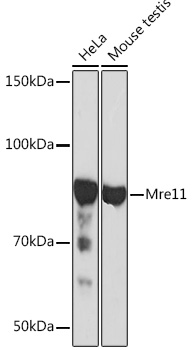Anti-Mre11 Antibody (CAB4222)
- SKU:
- CAB4222
- Product type:
- Antibody
- Reactivity:
- Human
- Mouse
- Host Species:
- Rabbit
- Isotype:
- IgG
- Research Area:
- Epigenetics and Nuclear Signaling
Description
| Antibody Name: | Anti-Mre11 Antibody |
| Antibody SKU: | CAB4222 |
| Antibody Size: | 20uL, 50uL, 100uL |
| Application: | WB |
| Reactivity: | Human, Mouse |
| Host Species: | Rabbit |
| Immunogen: | A synthesized peptide derived from human Mre11 |
| Application: | WB |
| Recommended Dilution: | WB 1:500 - 1:2000 |
| Reactivity: | Human, Mouse |
| Positive Samples: | HeLa, Mouse testis |
| Immunogen: | A synthesized peptide derived from human Mre11 |
| Purification Method: | Affinity purification |
| Storage Buffer: | Store at -20°C. Avoid freeze / thaw cycles. Buffer: PBS with 0.02% sodium azide, 0.05% BSA, 50% glycerol, pH7.3. |
| Isotype: | IgG |
| Sequence: | Email for sequence |
| Gene ID: | 4361 |
| Uniprot: | P49959 |
| Cellular Location: | |
| Calculated MW: | 81kDa |
| Observed MW: | 81KDa |
| Synonyms: | ATLD, HNGS1, MRE11A, MRE11B |
| Background: | This gene encodes a nuclear protein involved in homologous recombination, telomere length maintenance, and DNA double-strand break repair. By itself, the protein has 3' to 5' exonuclease activity and endonuclease activity. The protein forms a complex with the RAD50 homolog; this complex is required for nonhomologous joining of DNA ends and possesses increased single-stranded DNA endonuclease and 3' to 5' exonuclease activities. In conjunction with a DNA ligase, this protein promotes the joining of noncomplementary ends in vitro using short homologies near the ends of the DNA fragments. This gene has a pseudogene on chromosome 3. Alternative splicing of this gene results in two transcript variants encoding different isoforms. [provided by RefSeq, Jul 2008] |
| UniProt Protein Function: | MRE11A: a nuclear protein involved in homologous recombination, telomere length maintenance, and DNA double-strand break repair. By itself, the protein has 3' to 5' exonuclease activity and endonuclease activity. The protein forms a complex with the RAD50 homolog; this complex is required for nonhomologous joining of DNA ends and possesses increased single-stranded DNA endonuclease and 3' to 5' exonuclease activities. In conjunction with a DNA ligase, this protein promotes the joining of noncomplementary ends in vitro using short homologies near the ends of the DNA fragments. Alternative splicing results in two different isoforms. |
| UniProt Protein Details: | Protein type:DNA-binding; Cell cycle regulation; DNA repair, damage; Deoxyribonuclease Chromosomal Location of Human Ortholog: 11q21 Cellular Component: nucleoplasm; chromosome, telomeric region; Mre11 complex; cytosol; nucleus; chromatin Molecular Function:protein C-terminus binding; ATP-dependent DNA helicase activity; protein binding; nuclease activity; DNA binding; single-stranded DNA specific endodeoxyribonuclease activity; manganese ion binding; endonuclease activity; double-stranded DNA binding; 3'-5' exonuclease activity; endodeoxyribonuclease activity Biological Process: positive regulation of kinase activity; sister chromatid cohesion; negative regulation of DNA endoreduplication; telomere maintenance via telomerase; DNA repair; regulation of mitotic recombination; DNA catabolic process, endonucleolytic; positive regulation of protein amino acid autophosphorylation; DNA duplex unwinding; double-strand break repair via nonhomologous end joining; double-strand break repair via homologous recombination; DNA recombination; cell proliferation; intra-S DNA damage checkpoint; base-excision repair; nucleotide-excision repair; meiotic recombination; double-strand break repair; mitotic cell cycle G2/M transition DNA damage checkpoint; synapsis; positive regulation of interferon type I production; innate immune response; telomere maintenance; response to DNA damage stimulus Disease: Ataxia-telangiectasia-like Disorder 1 |
| NCBI Summary: | This gene encodes a nuclear protein involved in homologous recombination, telomere length maintenance, and DNA double-strand break repair. By itself, the protein has 3' to 5' exonuclease activity and endonuclease activity. The protein forms a complex with the RAD50 homolog; this complex is required for nonhomologous joining of DNA ends and possesses increased single-stranded DNA endonuclease and 3' to 5' exonuclease activities. In conjunction with a DNA ligase, this protein promotes the joining of noncomplementary ends in vitro using short homologies near the ends of the DNA fragments. This gene has a pseudogene on chromosome 3. Alternative splicing of this gene results in two transcript variants encoding different isoforms. [provided by RefSeq, Jul 2008] |
| UniProt Code: | P49959 |
| NCBI GenInfo Identifier: | 17380137 |
| NCBI Gene ID: | 4361 |
| NCBI Accession: | P49959.3 |
| UniProt Secondary Accession: | P49959,O43475, B3KTC7, |
| UniProt Related Accession: | P49959 |
| Molecular Weight: | 708 |
| NCBI Full Name: | Double-strand break repair protein MRE11A |
| NCBI Synonym Full Names: | MRE11 meiotic recombination 11 homolog A (S. cerevisiae) |
| NCBI Official Symbol: | MRE11A |
| NCBI Official Synonym Symbols: | ATLD; HNGS1; MRE11; MRE11B |
| NCBI Protein Information: | double-strand break repair protein MRE11A; AT-like disease; MRE11 homolog 1; MRE11 homolog A; endo/exonuclease Mre11; meiotic recombination 11 homolog 1; meiotic recombination 11 homolog A; DNA recombination and repair protein |
| UniProt Protein Name: | Double-strand break repair protein MRE11A |
| UniProt Synonym Protein Names: | Meiotic recombination 11 homolog 1; MRE11 homolog 1; Meiotic recombination 11 homolog A; MRE11 homolog A |
| Protein Family: | Double-strand break repair protein |
| UniProt Gene Name: | MRE11A |
| UniProt Entry Name: | MRE11_HUMAN |




